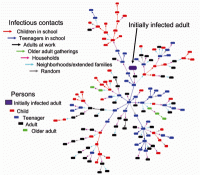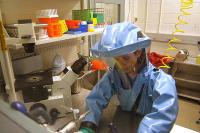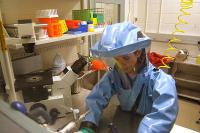-
Solving the mystery of arsenic-contaminated water
Can water ever be too clean? If the intent is to store it underground, the answer, surprisingly, is yes. In a new study, scientists have shown that recycled water percolating into underground storage aquifers in Southern California picked up trace amounts of arsenic because the water was too pure. The research sheds light on a poorly understood aspect of groundwater recharge with purified recycled water, namely the potential mobilization of arsenic. Arsenic is a naturally occurring element that can cause organ failure and cancer in humans with prolonged exposure above established health thresholds. The findings pose a problem for Orange County, California, which differs from most communities in that it purifies treated wastewater instead of discharging it directly into rivers and oceans – but the problem goes beyond Orange County.
-
-
New research aims to slow the spread of infectious diseases

Emerging pandemic disease outbreaks such as Ebola increasingly threaten global public health and world economies, scientists say. We can expect five such new diseases to emerge each year — and spread. The tropical disease dengue fever, for example, has made its way to Florida and Texas, seemingly to stay. The NSF’s Ecology and Evolution of Infectious Diseases (EEID) program supports research aiming to help understanding of the underlying ecological and biological mechanisms behind human-induced environmental changes and the emergence and transmission of infectious diseases. This year, the program has awarded eight new grants totaling $18 million.
-
-
New book details safety, security methods for biosciences sites
Recent mishaps at laboratories which mishandled potentially dangerous biological substances and the transmission of the Ebola virus in a U.S. hospital are symptoms at bioscience facilities that two Sandia National Laboratories researchers think could be prevented by implementing the practices in a new book on biorisk management. The new book, Laboratory Biorisk Management: Biosafety and Biosecurity, is the first full-length manuscript on the detailed implementation of biorisk management.
-
-
EU-funded research: Climate change and food safety
The global fresh produce supply chain must take into account climate change in order to ensure food safety, warn EU-funded researchers. This was the key recommendation of the EU-funded VEG-I-TRADE project, which was launched in 2010 to assess the safety of fresh produce in a rapidly evolving context of climate change and expanding international trade.
-
-
Long-distance travelers may contribute to the spread of antibiotic resistance
Swedish exchange students who studied in India and in central Africa returned from their sojourns with an increased diversity of antibiotic resistance genes in their gut microbiomes. These resistance genes were not particularly abundant in the students prior to their travels, but the increases are nonetheless quite significant. The researchers questioned the conventional wisdom that overuse of antibiotics was entirely responsible for the surge in resistance, despite the fact that overuse is a huge problem.
-
-
New drug protects against nuclear radiation’s deadly effects 24 hours after exposure
The threat of a nuclear incident, with the potential to kill or injure thousands of people, has raised global awareness about the need for medical countermeasures that can prevent radiation-induced bodily damage and keep people alive, even if given a day or more after contact with nuclear radiation. An interdisciplinary research team reports a breakthrough in countering the deadly effects of radiation exposure. A single injection of a regenerative peptide was shown significantly to increase survival in mice when given twenty-four hours after nuclear radiation exposure.
-
-
Toxic chemical found in fish-eating in birds outside of a Georgia’s Superfund site
Researchers have found that a contaminated mixture called Aroclor 1268 has spread beyond a former chemical plant, now a Superfund site, near Brunswick, Georgia. Aroclor 1268 is composed of a suite of toxic chemical compounds known as polychlorinated biphenyls, or PCBs. The chemical was used to produce insulation materials at the Linden Chemical Plant at the Turtle Estuary near Brunswick until 1994.
-
-
Two major U.S. aquifers contaminated with high levels of natural uranium
Nearly two million people throughout the Great Plains and California live above aquifer sites contaminated with natural uranium which is mobilized by human-contributed nitrate. Data from roughly 275,000 groundwater samples in the High Plains and Central Valley aquifers show that many Americans live less than two-thirds of a mile from wells that often far exceed the uranium guideline set by the Environmental Protection Agency. A new study reports that 78 percent of the uranium-contaminated sites were linked to the presence of nitrate, a common groundwater contaminant that originates mainly from chemical fertilizers and animal waste.
-
-
What if it happened again? What we need to do to prepare for a nuclear event
As we observe the 70th anniversary of the bombings of Hiroshima and Nagasaki, it may seem like the threat from nuclear weapons has receded. But it hasn’t; the threat is actually increasing steadily. This is difficult to face for many people, and this denial also means that we are not very well-prepared for nuclear and radiological events. Any nuclear weapon exchange or major nuclear plant meltdown will immediately lead to a global public health emergency. The Ebola outbreak taught the world that we should have resources in place to handle a major health emergency before it happens. What would a Nuclear Global Health Workforce need to be prepared to manage? For that we can look back at the legacy of the atomic bombings of Hiroshima and Nagasaki, as well as the nuclear accidents like Chernobyl and Fukushima.
-
-
Researchers carefully protect dangerous pathogens – but how secure are all their data?

Ebola, smallpox, anthrax and many others: the most dangerous microorganisms are strictly regulated in the United States. The federal government oversees use of sixty-five so-called select agents with “the potential to pose a severe threat to public, animal or plant health, or to animal or plant products.” There has never been as much research performed with these pathogens —to learn more, find cures, or create vaccines — as in the past decade. The sprawl of high containment laboratories has led to a parallel increase in individuals with access to these agents. As of January 2015, approximately 11,000 individuals were on the list. The deadly infectious agents must be kept safely under lock and key, where they can’t threaten the general population or fall into the wrong hands. But even the most physically secure research lab could be the site of a devastating data security breach. As they stand now, information security guidelines published by science regulators with regard to select agents lack the critical level of detail needed to protect data effectively.
-
-
Agroterrorism a serious risk to Americans, U.S. economy: Experts
The word “terrorism” is typically associated with bomb and bullets, but security experts say that there are other types of terrorism which may bring death and disruption, chief among them is agroterrorism. Agroterrorism is the use of animal or plant pathogens to disrupt a nation’s food supply, or use the food supply to spread deadly disease.In 2004, Tommy Thompson, then secretary of Health and Human Services, said that, “For the life of me, I cannot understand why the terrorists have not attacked our food supply, because it is so easy to do.”
-
-
Toxic blue-green algae a growing threat to nation’s drinking, recreational water
A new report concludes that blooms of toxic cyanobacteria, or blue-green algae, are a poorly monitored and underappreciated risk to recreational and drinking water quality in the United States, and may increasingly pose a global health threat. Several factors are contributing to the concern. Temperatures and carbon dioxide levels have risen, many rivers have been dammed worldwide, and wastewater nutrients or agricultural fertilizers in various situations can cause problems in rivers, lakes, and reservoirs.
-
-
U.K. conducted chemical weapons experiments on “unconsenting participants”
In 1963 the U.K. Ministry of Defense’s Porton Down military science center carried out the first of a series of tests to release zinc cadmium sulphide in the atmosphere over Norwich. It was one of many examples of secret experiments conducted in the name of military research during the 1950s and 1960s, now chronicled for the first time in a new book. The book provides a comprehensive overview of state military scientific research on chemical and biological weapons by Britain, the United States, and Canada since the First World War. Between 1946 and 1976, “Britain was turned into a large-scale open-air laboratory; her people into an army of unconsenting participants,” the author writes.
-
-
Polluting waterways with antibiotics may create superbugs of tomorrow
Researchers have proved for the first time that even low concentrations of antibiotics are polluting waterways. Using low, realistic concentrations of antibiotics that might be found in waste water, the team showed a series of worrying effects on both environmental and clinical bacteria, including rearrangements of the bacterial DNA, changes in the colonies that the bacteria form, and most importantly, the evolution of antibiotic-resistant strains.
-
-
Single dose Ebola vaccine is safe and effective in monkeys against outbreak strain

National Institutes of Health (NIH) scientists report that a single dose of an experimental Ebola virus (EBOV) vaccine — VSV-EBOV — completely protects cynomolgus macaques against the current EBOV outbreak strain, EBOV-Makona, when given at least seven days before exposure, and partially protects them if given three days prior. The scientists also observed that the experimental VSV-EBOV vaccine appears to provide initial protection by triggering innate virus-fighting host responses; these responses partially protected animals challenged with EBOV-Makona within a week after vaccination.
-
More headlines
The long view
Ransomware Attacks: Death Threats, Endangered Patients and Millions of Dollars in Damages
A ransomware attack on Change Healthcare, a company that processes 15 billion health care transactions annually and deals with 1 in 3 patient records in the United States, is continuing to cause massive disruptions nearly three weeks later. The incident, which started on February 21, has been called the “most significant cyberattack on the U.S. health care system” by the American Hospital Association. It is just the latest example of an increasing trend.
